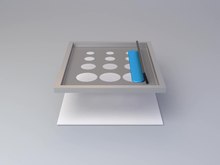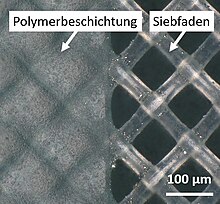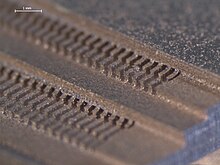3D screen printing process
3D screen printing ( English 3D screen printing ) is a binder-based, additive shaping process from the process group of material extrusion . 3D screen printing combines high resolution with high productivity. In 3D printing , a suspension (printing paste) is pressed through a printing form (screen printing screen, stencil) with a doctor blade , layer by layer .
3D screen printing is suitable for mass production (5,000 to several million pieces per year) of small (base area 1 to 50 mm), flat (0.1 to approx. 50 mm) components with high detail resolution (structures from 70 µm), surface quality ( Mean roughness , Ra = 2 µm) and high ratio of height to width ( aspect ratio , up to 100: 1). Metallic and ceramic materials can be processed; just like material combinations. A specialty is the production of closed cavities .
The process was patented in 1992.
Procedure
3D screen printing is divided into the following sub-processes:
- Production of a so-called green body by repeating the process steps: flooding, printing and curing until the desired green body component height is reached
- possibly mechanical processing of the green body
- Solidifying the green body by sintering
Floods
The printing paste is evenly distributed on the screen printing screen with a flood squeegee (flooding). The purpose of flooding is to fill the screen mesh with printing paste. No printing takes place during flooding.
To press
When printing, another squeegee, the so-called pressure squeegee, is drawn over the screen printing screen. The contact pressure of the printing squeegee is chosen so that the screen mesh is pressed down to the surface of the printing substrate during printing. When the screen comes into contact with the surface of the printing material, the printing paste is transferred from the filled screen mesh to the surface of the printing substrate.
Harden
The curing or drying of each print layer is carried out by thermal expulsion of solvents or water with IR radiation or by activating a hardener z. B. by UV radiation . In printing terms, the activation of a hardener with UV radiation is also understood as "drying".
Green processing
If the process steps of flooding / printing / curing are repeated sufficiently often, a mechanically stable, mostly open-pore green body is present. A binder bonds the individual powder particles together in the green body. Green bodies can be further processed by means of machining processes (drilling, turning, milling, etc.), or they can be combined with other green bodies to form more complex structures using joining processes.
Sintering
Sintering is a heat treatment below the melting temperature of the printed material. During sintering, material transport processes cause the powder body to compact. The porosity decreases, the strength increases and the external dimensions of the sintered component decrease ( shrinkage ). The shrinkage of 3D screen-printed components is between 5 and 20% (linear).
Before sintering, the organic auxiliary materials (hardeners, binders, etc.) are removed from the green compact (debinding). This is usually done by heat treatment (thermal debinding) or, more rarely, by washing out with solvents (solvent debinding). Since the green bodies printed with 3D screen printing are open-pored, high heating rates can be achieved during debinding.
Printing paste
Printing paste generally consists of the following components:
- Carrier medium (water or organic solvent)
- Solid particles (ceramic or metallic particles)
- Binder (bonds the solid particles after hardening)
- Additives (serve to disperse the solid particles, adjust the viscosity and regulate the drying and wetting behavior)
It is possible to mix powders with different particle sizes into printing pastes. There is no limit to a minimum particle size. The maximum particle size depends on the opening width of the mesh used.
Printing forms: screen printing screens and stencils
Screen printing screens
Screen printing screens consist of a metal frame with a tightly stretched polymer or metal wire mesh that is glued into the metal frame. According to the desired print layout, the screen fabric has a polymer layer that seals the non-printing areas of the screen fabric. This ensures that the printing paste is only pressed through those parts of the screen mesh that are required for the print layout. Different wire materials, wire thicknesses, screen tensions and frame sizes are commercially available.
Stencils
Stencils consist of a metal frame into which a metal foil has been glued instead of a screen mesh. The metal foil with a thickness of 100 to 500 µm contains openings made by means of laser cutting, chemical etching or similar processes. In contrast to screen printing screens, stencils are characterized by a higher printable layer thickness. However, print layouts such as hollow ring structures are difficult or impossible to print with stencils.
properties
Material selection
With 3D screen printing, in principle, all materials can be processed that are available in powder form and whose sintering temperature is above the temperature required to drive out the binder. So far, the processing of industrially relevant materials, such as alloys based on steel (1.4404, 1.4542), nickel , copper , titanium , ceramics , glasses and hard metals , has been successful . There is also the option of combining different materials such as metals and ceramics.
Component design
Small (base 1 to 50 mm) and flat (height 0.1 to 50 mm) components that have no or only a few changes in level are ideal for production with 3D screen printing. A high degree of freedom in the design of the components is achieved through optional screen changes. This makes it possible to print complex components with overhangs, undercuts or closed cavities - which cannot be produced at all or can only be produced uneconomically using conventional manufacturing processes. In contrast to other powder-based generative processes, no supporting powder bed is required. This saves the so-called "depowdering" step and allows the production of completely closed cavities and complex internal channel structures. By changing the printing material during printing, components with a graded material structure can be produced.
Surface finish
Compared to other additive processes such as selective laser melting , components with a higher surface quality (Ra = 2 µm) can be manufactured with high precision . The reason for this is that in printing pastes for 3D screen printing, particles with a smaller diameter (down to less than 1 µm) can be used compared to powder-bed-based processes.
Wall thickness
By using fine powders, component resolutions from around 70 µm as well as thin channels with a wall spacing down to 100 µm and wall structures with an aspect ratio (height / width) of up to 100: 1 can be produced.
Suitability for large-scale production
3D screen printing is a mass production process particularly suitable for complex miniaturized components. For the productivity of the 3D screen printing process, the highest possible layer thickness of each printing layer (current state of the art: 5 - 150 µm with screen printing screens and> 150 µm with stencils), a short curing time, a high number of components on each print layout and a low one are important Component height.
Due to the possible footprint of the construction platform (300 × 300 mm up to 500 × 500 mm), theoretical construction rates of up to 5000 cm³ / h per printing station can be achieved, but taking into account the sintering shrinkage, the construction rate for real components is usually well below 1000 cm³ / h . In contrast to pressing or extrusion processes, which z. T. have considerable tool costs and tool production times, the costs and the time required to produce screen printing screens are significantly lower.
Despite the ongoing need for development, industrial line systems with automated printing and curing stations as well as integrated oven systems are already available for large-scale production. 3D screen printing shows significant positive economies of scale . That means a system with double output is not twice as expensive as a smaller one.
Fields of application
- Chemical / pharmaceutical industry (e.g. micro mixers and reactors)
- Electrical engineering (e.g. servomotors, electrical sheets)
- Energy technology (e.g. electronics cooling, fuel cell components)
- Mechanical engineering (e.g. turbine seals)
- Microsystem technology (e.g. electrodes, actuators, integrated sensors)
- Pneumatics (e.g. solenoid valves )
- Jewelry industry
Individual evidence
- ↑ a b c d e T. Studnitzky; M. Jurisch; K. Reuter; A. Strauss; S. Riecker; M. Dressler: 3D Screen and Stencil Printing: Real Mass Production For Metals, Ceramics And Their Combinations . Ed .: Proceedings - World PM 2016. 2016, ISBN 978-1-899072-48-4 .
- ↑ a b c d e f g M. Dressler, S. Vasic: 3D screen printing: Filigree ceramic components in large-scale production . In: Ceramic magazine . tape 71 , no. 5 . Springer Verlag, 2019, p. 52-55 .
- ↑ Process for the production of moldings with a predetermined pore structure. Retrieved June 17, 2020 .
- ↑ Additive Manufacturing with 3D Screen Printing / Additive Manufacturing with 3D Screen Printing. Retrieved June 17, 2020 .
- ↑ a b M. Jurisch, T. Studnitzky, O. Andersen, B. Kieback: 3D screen printing - a pioneer for flexible additive manufacturing . In: Engineer materials . 2013.
- ↑ W. Schatt, K. Wieters, B. Kieback: Powder metallurgy - technologies and materials . Springer Verlag, 2007, ISBN 978-3-540-23652-8 .
- ↑ M. Lindner, J. Rudolph, P. Bräuer, R. Werner, S. Riecker, T. Studnitzky, B. Kieback: Three-dimensional screen printing as a material, energy and cost-efficient manufacturing method for components of electromagnetic energy conversion systems . In: Energy and material-saving production techniques. International ETG Congress Energy Supply on the Way to 2050 . Berlin 2013.
- ^ M. Dressler, T. Studnitzky, B. Kieback: Additive manufacturing using 3D screen printing . In: 2017 International Conference on Electromagnetics in Advanced Applications (ICEAA) . IEEE, Verona, Italy 2017, ISBN 978-1-5090-4451-1 , pp. 476–478 , doi : 10.1109 / ICEAA.2017.8065283 ( ieee.org [accessed January 1, 2020]).
- ↑ a b T. Studnitzky, A. Strauss, O. Andersen, G. Stephani, G. Walther, P. Quadbeck, J. Trapp, B. Kieback: Suspension and paste technology for the production of PM materials and components . In: Fachverband Pulvermetallurgie -FPM- (Ed.): Lectures and exhibitor contributions to the Hagen Symposium on November 25 and 26, 2010 in Hagen . Heimdall, Hagen 2010, p. 223-245 .
- ^ T. Studnitzky, A. Strauss: Precision components through screen printing to the power of three. Accessed January 1, 2020 .
- ^ M. Dressler, T. Studnitzky, B. Kieback: Inexpensive microcomponents with 3-D screen printing . In: IVAM eV Association for Microtechnology (ed.): Inno-Magazin . tape 20 , no. 62 , 2015, p. 3-4 .
- ↑ S. Vasic: 3-D screen printing revolutionizes additive manufacturing . In: Special print technical review . tape 111 , 2019.
- ↑ Fraunhofer IFAM. Retrieved June 17, 2020 .
- ↑ Exentis Group AG. Accessed January 1, 2020 .



